Production monitoring system - Industry 4 vs. Manual
For decisions makers in a firm to be able to take proper decisions, the production monitoring system must give them accurate and timely (as in instantaneous) data from machines. Here is an explanation of how manual production monitorng works, vs. how an Industry 4.0 based system works.
Manual production monitoring
This is how traditional manual production monitoring works. A person goes to every machine at the end of each shift, asks the operator for the production quantity, downtimes and rejections. The person notes these numbers in a register, then enters them in a computer. Since yesterday’s night shift ends today morning, yesterday’s data is entered today morning, a couple of hours after the night shift ends. Another person is in charge of analyzing the data, making reports, and giving them to senior management. These reports are used by the decision makers in the daily production meeting, to review yesterday’s production.
The data comes to decision makers through a human data chain after more than 24 hours. It is usually cooked up by the operator, the supervisor and the manager, to suit their convenience. So it is inaccurate, and too late to do anything if something requires immediate attention. The review in the morning production meeting is only a post-mortem examination of yesterday’s cooked up data, hence quite ineffective.
Harm caused by delayed and wrong data from production monitoring – some examples:
– A part running on a machine has a strict delivery schedule. There is a machine breakdown in the evening. Nobody at the decision making levels knows of the breakdown when it happens. They come to know of it only the next morning, and hence nobody is able to take any action on this crisis (like doing the part on another machine). Result: delivery slippage.
– Parts made today are entered in the ERP system after 1 or even 2 days. The invoice and transport documents can only be made after this time. Finished goods are lying in your factory for 1 or 2 days, and you lose interest for this period.
– Production quantities entered in the ERP system in each shift are cooked up and wrong. Shipping documents and the invoice are made for this quantity, which is actually not physically available when it is time for shipping. To overcome this problem you overproduce, resulting in inventory carrying cost.
Production monitoring system on Industry 4.0
In a production monitoring based on Industry 4.0 principles, data from machines comes automatically to you and to the ERP system.
The data is collected automatically, analyzed immediately by software, and available as reports within seconds. There is no manual data collection and entry , and no manual generation of reports.
You get alerts on your mobile phone or email when something happens that requires immediate attention.
A variety of reports are generated on production quantity, OEE, quality, maintenance, operator efficiency, consumables usage, and energy consumption.
Time to get data with an Industry 4.0 based production monitoring system: 1 minute.
Time to get data with a manual monitoring system: 1 day, or 1440 minutes.
So here is what an Industry 4.0 based production monitoring system does for you:
With Industry 4.0 based production monitoring: accurate data direct from machines, in seconds.
With the traditional paper-based production monitoring: inaccurate data after 24 hours.
What is Industry 4.0, in relation to production monitoring ?
This is how a production monitoring system based on Industry 4.0 works.
– It collects data directly from your machines 24/7, sends it over IoT to the cloud.
– Software on the cloud server stores the machine data in a database, and analyzes the data.
– The software then displays the data to you in easy-to-understand tables, graphs and charts.
– If there are any issues that require immediate attention, the production monitoring software sends you alerts on the mobile phone or email.

There is a set of design principles that define Industry 4.0
Interoperability: The ability of machines, devices, sensors, and people to communicate with each other over the Internet.
Information transparency: The ability to capture activities of machines through electronic sensors, store this data, and process it for other purposes.
Technical assistance: First, the ability to support humans by reporting and alerting, so that humans can and take decisions. Second, the ability to support humans by performing tasks that are unpleasant, exhausting, or unsafe.
Decentralized decisions: The ability to make decisions and perform tasks as autonomously (independent of humans) as possible. Decisions and tasks are delegated to humans only if they are very difficult or involve conflicting goals. The extent to which each of these principles is implemented in production monitoring can vary, and will increase as years go by, as technology advances.
In sum, Industry 4.0 is any automation system in industry that is characterized by the capture, transfer and analysis of data using sensors connected to machines, the internet and cloud. It is a broad definition, and does not include any absolutes or measures like how much interoperability, how much technical assistance, etc. A production monitoring system based on Industry 4.0 principles uses these features to provide accurate and instant data from machines.
Your specific production monitoring system will be based on:
– Your pain points, what you want out of production tracking.
– Your budget
– Ability to make culture changes in your organization
– Benefits that you want to see from implementing production tracking.
Some myths, jargon and misinformation - cleared up
Industry 4.0 for some reason is full of misinformation, jargon and hype. If you are new to it, you will tend to get scared by all the ‘high tech’. Here is an explanation that clears the confusion, simplifies the technology.
What Industry 4.0 is NOT (or does not HAVE to be)
There is nothing like an Industry 4 standard
The moment you connect your machine to your computers and can see what it is up to at any time, that is Industry 4.0.
There is nothing like ‘Industry 4.0 compliant’
After you connect machines to your computers, you decide what features you want to add, based on benefits that you see from each.
There are no specific technologies that your system needs to have
There is this misconception that Industry 4.0 compulsorily includes Additive manufacturing (3D printing), Virtual Reality (VR), Augmented Reality (AR), Robots, and automated machines. These need not be a part of your production monitoring system at all.
Does ‘Conforms to Industry 4.0 standard ’ have any meaning ?
NO.
The term is meaningless. There is no Industry 4.0 standard, and hence no yardstick that you can use to say ‘This system conforms to the Industry 4.0 standard’. It is merely a term used to denote a kind of automation characterized by the capture, transfer and analysis of data using sensors connected to machines, the internet and cloud.
There are a lot of evolving standards for the different components of Industry 4.0 (sensor, Cloud, IOT, etc.) and the manner in which they communicate (the protocols, security, etc.), but there is no standard that says “This is Industry 4.0, while this is not”. If there is a production monitoring system that follows the design principles enumerated above, it is Industry 4.0.
Is there a single definition of Industry 4.0 ?
NO.
The reality is that your requirements decide your Industry 4 definition, and there is no single one. Industry 4.0 is not an ABSOLUTE definition. It is the TREND towards automation and data exchange in manufacturing technologies and processes which include sensors , IoT, and cloud computing, with software making a lot of decisions that humans used to make earlier.
Is Industry 4.0 some earth-shaking new technology (that we must be scared of) ?
NO.
Just look at its components – machines, sensors, the internet, IOT, cloud software. All these are familiar to us.
Machines have been around for centuries.
Sensors have been used on machines for decades – for fluid pressure, temperature, speeds, etc. Even the thermometer and BP measuring device we use at home are sensors.
Internet we have been using for a couple of decades now. IoT is just things (like our cell phones) using the internet instead of humans.
Software has been around for a few decades.
None of them is new or revolutionary technology.
What is revolutionary is these technologies working together to connect our manufacturing machines to computers, ours and our organization’s.
Jargon – the ‘need to know’, and ‘can throw in the dustbin’
You’ll be bombarded with jargon by developers and sellers of production monitoring systems, and financial gurus talking about how Industry 4.0 is going to ‘change our lives’.
Like any equipment, there are aspects of a production monitoring system that are the domain of the developers of the equipment, and other aspects that are the domain of the users of the equipment (that’s you). When you are buying a CNC machine, for example, you need to know about accuracies, vibration levels, speeds, etc. – basically what the machine can do, not how it it does it. Why should you be burdened with the maths of complex tool path interpolation strategies or the functioning of individual chips on the controller board ? Strangely, discussions on production monitoring systems are for some reason polluted with information that you do not need, taking the focus away from what the system can do for you in production monitoring.
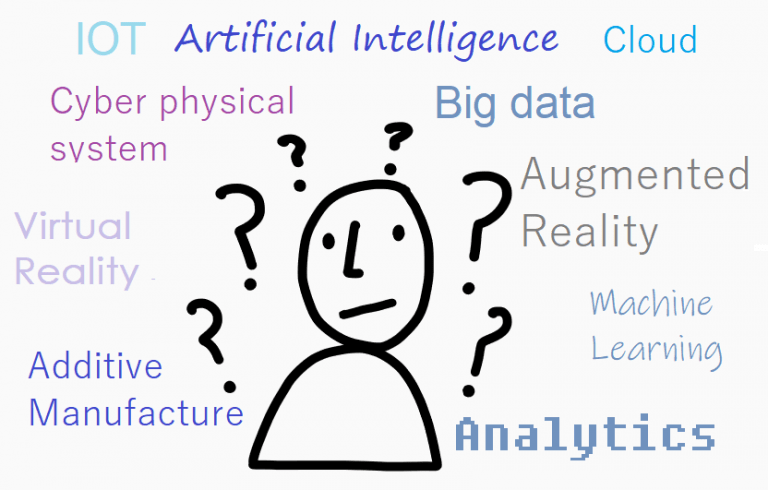
Here is a list of useful jargon that you need to know, the useless stuff that you can throw out of the window, and the misinformation that you can ignore.
What you need to know
Cloud
Computers and software in central locations, connected by high speed internet, instead of being within the organization. This post has more on it.
IoT (Internet of Things) and IIoT (Industrial Internet of Things)
IoT is the same old internet, used by things (devices) instead of people. IoT and IIoT are the same, but when IoT is used in industry, it is called IIoT. Just another acronym adding to the confusion. This post has more on it.
Digitalization
Just another word for Industry 4.0.
Digitalization is moving towards computerization of your organization’s data collection, analysis, and reporting to improve efficiency and profits. Most organizations will already have this to a substantial extent outside the shop floor, in the office. The new use of this term is on the shop floor.
Note that Digitization is different from Digitalization. This is the conversion of analog data to digital. E.g., converting your old printed part drawings into CAD format.
What you NEED NOT know, that are the product developer’s problem
Cyber physical system
A collective term that refers to the machine plus sensor. This post has more on it.
Big data
Handling of very large amounts of data that keeps growing rapidly. Handling means storage, cataloging, accessing and analyzing this data. Large volume data handling, done at high speed, with high accuracy.
Analytics
Accessing and analysis (computation, filtering, sorting, etc,) of data followed by reporting or alerting to people or communicating to other software. The data could be collected from machines, people, and other software.
Artificial Intelligence (AI)
This is ‘intelligence’ demonstrated by machines, unlike the natural intelligence displayed by humans and animals. Any logic that enables a machine or device to perceive its environment and take actions to achieve a goal. In Leanworx production monitoring, a lot of AI is used to capture, filter, improve and analyze data from machines.
Machine Learning (ML)
The science of getting computers to learn and do something themselves without being actually programmed to do it. Like humans learning from experience. The software improves its decision making capability on its own, without being initially being programmed that way. Example: “Ok, when the vibrations reached this level, I informed the humans and they asked me to reduce the RPM to 500. Next time I’ll do it myself”. ML is a means of achieving AI.
What you NEED NOT know, UNLESS they are part of your operation
For some unknown reason, some technologies are (wrongly) considered an essential part of Industry 4.0, and always mentioned with Industry 4.0 by Gurus in speeches and articles. Some favorites are Additive manufacture, Virtual reality and Robotics. They make it sound like it is Industry 4.0 only if you have these as part of your manufacturing processes. This gets quite worrying after a while, getting you thinking “Is what I am doing even worthy of being called Industry 4.0 ?”. Note that there is no such thing as an Industry 4.0 ‘standard’. There is no specified level of automation, specified manufacturing processes, etc.
Additive manufacture
Also called 3D printing. This involves building products by adding material layer by layer. Additive manufacturing starts off with nothing, and builds a part by adding material. It is done with various materials, most commonly plastics and metal. Subtractive manufacturing is what we have been doing traditionally. It starts off with raw material, and removes material to create parts. Additive manufacturing is NOT a necessary part of Industry 4.0, and Industry 4.0 implementation in your organization does not require 3D printing machines.
Robotics
Robots are NOT a necessary part of Industry 4.0. Industry 4.0 implementation in your organization does not require robots.
High Automation levels
You could have a whole lot of manually operated machines. All your material handling could be manual, and every single part of yours could involve manual intervention. High automation, is NOT a necessary part of Industry 4.0. The production monitoring system in your organization does not require this.
Virtual Reality (VR)
Virtual Reality is a 3-D environment that is generated by a computer, which can be explored and interacted with by a person. E.g., you can learn about a machine with just a fully simulated machine and no physical machine.
Augmented Reality (AR)
Augmented Reality overlays digital information onto a physical world. E.g., you point your mobile phone camera at a machine part, the software recognizes what part it is, and gives you detailed information about the part for machine operation or maintenance.
Action point
When you are planning on implementing a production monitoring system based on Industry 4.0, remember that Industry 4.0 is merely a term used to denote a kind of automation characterized by the capture, transfer and analysis of data using sensors connected to machines, the internet and cloud.
Please use the rules above to filter out the redundant terms and buzzwords from your conversations with vendors and consultants, and make your discussions meaningful.
Etc
The beautiful Old City of Ahmedabad
The Old city part of Ahmedabad is 600 years old, built by Ahmad Shah I (after whom the city itself is named). It is roughly square, about 3 km x 3 km. It had a fortified wall all around to protect against invaders, with 21 large gates. The gates still exist though the (presumably) wooden shutters don’t.
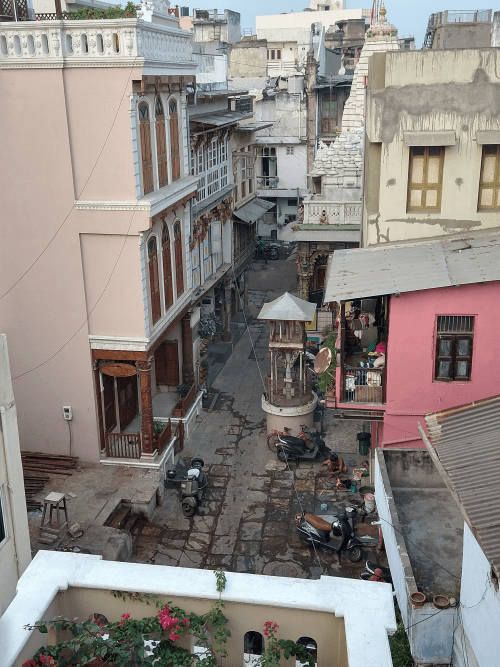

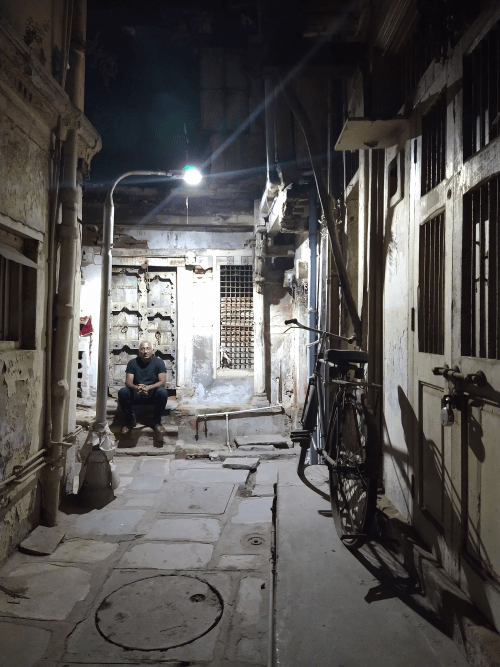
Amazingly, the city has survived almost unchanged since it was built. It is a collection of around 360 Pols, or residential colonies. Each Pol in turn had a gate for its protection, and homes were closely packed so people could actually move between homes on the roof top – must have been a nightmare for attackers. If town planning focused so much on defences, it makes one wonder how much time rulers of various kingdoms spent attacking each other versus sitting around and relaxing (or maybe it’s because they didn’t have TV and potato chips then, and didn’t know what to do with their time).
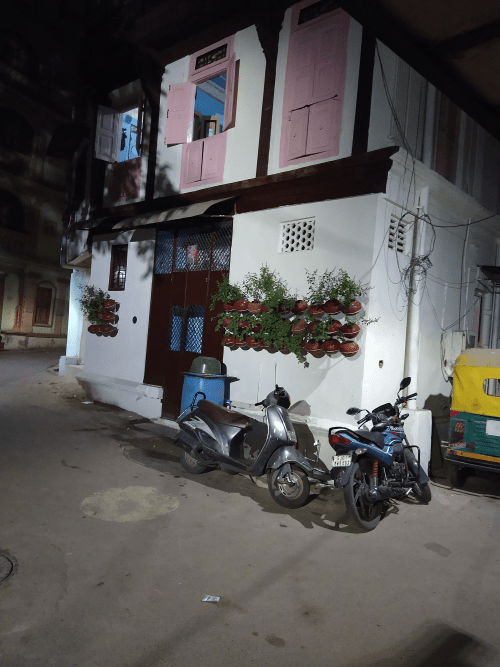

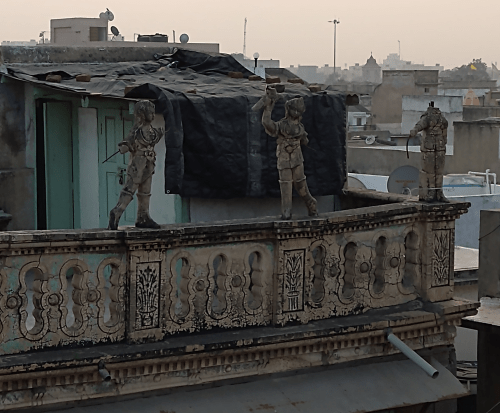
The houses in the Pols used a lot of wood in the construction, much of it crumbling now of course. In keeping with the architecture of those days, form is as important as function in the architecture here, and there’s art in the most unlikely places and structures. Each Pol also has a little square for people to hang around in, around a Chabutro or bird feeder.
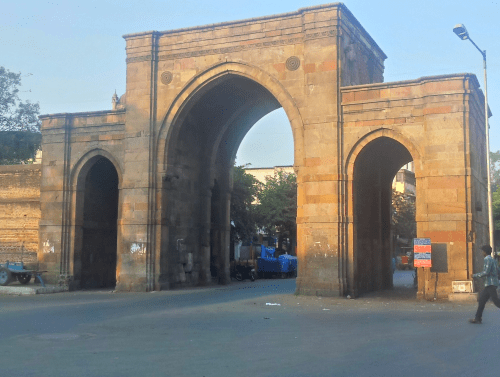
The narrow streets in the Pols do not allow movement of cars, and barely allow scooters and bikes. The Pols are therefore cozy, peaceful places with children playing in the streets and cows lazing around.
The Old City is now a UNESCO Heritage City, and hence seeing a lot of revival and reconstruction.


